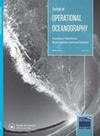The Stokes drift in ocean surface drift prediction
IF 2.4
3区 地球科学
Q4 METEOROLOGY & ATMOSPHERIC SCIENCES
引用次数: 7
Abstract
ABSTRACT The importance of explicitly resolving the Stokes drift in ocean surface drift modelling is demonstrated by comparing four models with 58,612 observational data points obtained from undrogued drifting buoys in the Estuary and Gulf of St. Lawrence, Canada. Drift model inputs are obtained from regional atmosphere and ocean circulation, and spectral wave models. The control drift model considers near-surface currents provided by the top grid cell of the ocean circulation model, which is 5-m thick, and a correction term proportional to the near-surface wind. The three other drift models account for the unresolved near-surface current shear by extrapolating the near-surface currents to the surface assuming Ekman dynamics. Two of these models consider explicitly the Stokes drift, with and without a wind correction term. Proposed models reduce the mean separation distance between observed and predicted trajectories by 34–40% relative to the control model, on average, for forecast times ranging from 3 to 72 h. The best improvement with respect to all metrics used is, however, obtained for the model that takes into account the near-surface shear correction and the Stokes drift, without any wind correction term (skill score of 0.93 after 3 h and 0.81 after 72 h).海洋表面漂移预测中的Stokes漂移
通过比较四个模型与加拿大圣劳伦斯河口和海湾未灌水漂流浮标的58,612个观测数据点,证明了明确解决Stokes漂移在海洋表面漂移建模中的重要性。漂移模式输入来自区域大气和海洋环流,以及谱波模式。控制漂移模型考虑了海洋环流模型顶格单元提供的近地面流,其厚度为5 m,并考虑了与近地面风成比例的校正项。其他三种漂移模型通过假设Ekman动力学将近地表流外推到地表来解释未解析的近地表流切变。其中两个模型明确地考虑了斯托克斯漂移,有和没有风修正项。在3至72小时的预测时间内,与控制模型相比,所提出的模型将观测轨迹与预测轨迹之间的平均分离距离平均减少了34-40%。然而,考虑近地面切变校正和Stokes漂移的模型在所有使用的指标方面取得了最好的改进,没有任何风校正项(3 h后的技能得分为0.93,72 h后的技能得分为0.81)。
本文章由计算机程序翻译,如有差异,请以英文原文为准。
求助全文
约1分钟内获得全文
求助全文
来源期刊
CiteScore
7.50
自引率
9.70%
发文量
8
审稿时长
>12 weeks
期刊介绍:
The Journal of Operational Oceanography will publish papers which examine the role of oceanography in contributing to the fields of: Numerical Weather Prediction; Development of Climatologies; Implications of Ocean Change; Ocean and Climate Forecasting; Ocean Observing Technologies; Eutrophication; Climate Assessment; Shoreline Change; Marine and Sea State Prediction; Model Development and Validation; Coastal Flooding; Reducing Public Health Risks; Short-Range Ocean Forecasting; Forces on Structures; Ocean Policy; Protecting and Restoring Ecosystem health; Controlling and Mitigating Natural Hazards; Safe and Efficient Marine Operations

 求助内容:
求助内容: 应助结果提醒方式:
应助结果提醒方式:


